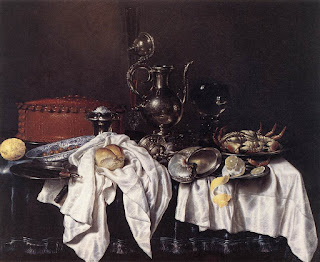Black Paint - Keeping Dark Areas Velvety
 |
| Still Life with Pie, Silver Ewer and Crab by Willem Claeszoon Heda (1658) Oil on canvas Frans Hals Museum, Haarlem |
Black Paint Types:
Ivory Black
Made from inorganic synthetic carbon black and Calcium Phosphate. First called Bone Black was invented by the Romans using burnt animal bones. For a nice good grade they began using ivory instead of the animal bones. Ivory Black has a higher carbon content than Bone Black giving it better intensity.
Technical investigation of Rembrandt's paintings has been conducted by Hermann Kühn in 1977. The pigment analyses of some thirty paintings have shown that Rembrandt's palette consisted of the following pigments: lead white, various ochres, Vandyke brown, bone black, charcoal black, lamp black, vermilion, madder lake, azurite, ultramarine, yellow lake and lead-tin-yellow.
 |
| Self-Portrait with Beret and Turned-Up Collar (1659), National Gallery of Art, Washington, D.C |
Lamp Black
Carbon Black first made with burning vegetable oils. Today’s methods produce the Lamp Black with tar, creosote, naphthalene, or other petroleum products. Since it is the slowest drying black oil paint it should be use with thin layers or mixed with a fast drying medium.
 |
| Supper at Emmaus by Caravaggio, 1601 |
Mars Black
A non-toxic pigment produced starting in the early 20th century. It is a fast drier and has a slight warm tone. A nice fairly flexible pigment unlike the brittle Lamp and Ivory Blacks.
I prefer not to use black paint, instead I use a mix of ultramarine, alizarin crimsom and burnt umber pigmants, applying thin transparent layers. This will maintain surface luster without the glare on brush strokes, setting the dark areas in the back lower layers. In contrast, the heavy opaque white or light areas show the glare of brush strokes creating a 3D effect.
 |
| Vermeer's Art of Painting or The Allegory of Painting (c. 1666–68) |


